Selecting the Best Band Ratio to Estimate Chlorophyll-a Concentration in a Tropical Freshwater Lake Using Sentinel 2A Images from a Case Study of Lake Ba Be (Northern Vietnam)
Abstract
1. Introduction
2. Materials and Methods
2.1. Study Area
2.2. Field Measurement and Sampling
2.3. Image Pre-Processing
2.4. Algorithms for Estimation of Chla
3. Results and Discussion
3.1. Lake Ba Be Water Features
3.2. Distribution of Chla in Lake Ba Be Water in Space and Time
3.3. Consistency of the Band Ratioselection
4. Conclusions
Acknowledgments
Author Contributions
Conflicts of Interest
References
- Carlson, R.E. A trophic state index for lakes. Limnol. Oceanogr. 1977, 22, 361–369. [Google Scholar] [CrossRef]
- Baban, S.M.J. Trophic classification and ecosystem checking of lakes using remotely sensed information. Hydrol. Sci. J. 1996, 41, 939–957. [Google Scholar] [CrossRef]
- Kasprzak, P.; Padisák, J.; Koschel, R.; Krienitz, L.; Gervais, F. Chlorophyll a concentration across a trophic gradient of lakes: An estimator of phytoplankton biomass? Limnol. Ecol. Manag. Inland Waters 2008, 38, 327–338. [Google Scholar] [CrossRef]
- U.S. Environmental Protection Agency (USEPA). National Lakes Assessment: A Collaborative Survey of the Nation’s Lakes; EPA 841-R-09-001; U.S. Environmental Protection Agency, Office of Water and Office of Research and Development: Washington, DC, USA, 2009; 103p. Available online: https://www.epa.gov/sites/production/files/2013-11/documents/nla_newlowres_fullrpt.pdf (assessed on 4 July 2017).
- UNEP. Review of Existing Water Quality Guidelines for Freshwater Ecosystems and Application of Water Quality Guidelines on Basin Level to Protect Ecosystems. In Proceedings of the First International Environment Forum for Basin Organizations towards Sustainable Freshwater Governance, Nairobi, Kenya, 26–28 November 2014; Available online: https://wedocs.unep.org/rest/bitstreams/35090/retrieve (assessed on 4 July 2017).
- Schalles, J.F. Optical remote sensing techniques to estimate phytoplankton chlorophyll a concentrations in coastal waters with varying suspended matter and CDOM concentrations. In Remote Sensing and Digital Image Processing; Springer International: Dordrecht, The Netherlands, 2006; Volume 9, pp. 27–79. [Google Scholar]
- Bukata, R.P. Retrospection and introspection on remote sensing of inland water quality: “Like Déjà Vu All Over Again”. J. Gt. Lakes Res. 2013, 39, 2–5. [Google Scholar] [CrossRef]
- Palmer, S.C.J.; Kutser, T.; Hunter, P.D. Remote sensing of inland waters: Challenges, progress and future directions. Remote Sens. Environ. 2015, 157, 1–8. [Google Scholar] [CrossRef]
- Ritchie, J.C.; Zimba, P.V.; Everitt, J.H. Remote Sensing Techniques to Assess Water Quality. Photogramm. Eng. Remote Sens. 2003, 69, 695–704. [Google Scholar] [CrossRef]
- Schalles, J.F.; Gitelson, A.A.; Yacobi, Y.Z.; Kroenke, A.E. Estimation of chlorophyll a from time series measurements of high spectral resolution reflectance in an eutrophic lake. J. Phycol. 1998, 34, 383–390. [Google Scholar] [CrossRef]
- O’Reilly, J.E.; Maritorena, S.; Mitchell, B.G.; Siegel, D.A.; Carder, K.L.; Garver, S.A.; Kahru, M.; McClain, C. Ocean color chlorophyll algorithms for SeaWiFS. J. Geophys. Res. 1998, 103, 24937–24953. [Google Scholar] [CrossRef]
- Kallio, K.; Koponen, S.; Pulliainen, J. Feasibility of airborne imaging spectrometry for lake monitoring—A case study of spatial chlorophylla distribution in two meso-eutrophic lakes. Int. J. Remote Sens. 2003, 24, 3771–3790. [Google Scholar] [CrossRef]
- D’Sa, E.J.; Miller, R.L. Bio-optical properties in waters influenced by the Mississippi River during low flow conditions. Remote Sens. Environ. 2003, 84, 538–549. [Google Scholar] [CrossRef]
- Dekker, A.G.; Peters, S.W.M. The use of the Thematic Mapper for the analysis of eutrophic lakes: A case study in the Netherlands. Int. J. Remote Sens. 1993, 14, 799–821. [Google Scholar] [CrossRef]
- Ritchie, J.C.; Schiebe, F.R.; Cooper, C.M.; Harrington, J.A. Chlorophyll Measurements in the Presence of Suspended Sediment Using Broad Band Spectral Sensors Aboard Satellites. J. Freshw. Ecol. 1994, 9, 197–206. [Google Scholar] [CrossRef]
- Gitelson, A. The peak near 700 nm on radiance spectra of algae and water: Relationships of its magnitude and position with chlorophyll concentration. Int. J. Remote Sens. 1992, 13, 3367–3373. [Google Scholar] [CrossRef]
- Gitelson, A.A.; Dall’Olmo, G.; Moses, W.; Rundquist, D.C.; Barrow, T.; Fisher, T.R.; Gurlin, D.; Holz, J. A simple semi-analytical model for remote estimation of chlorophyll-a in turbid waters: Validation. Remote Sens. Environ. 2008, 112, 3582–3593. [Google Scholar] [CrossRef]
- Gitelson, A.A.; Gurlin, D.; Moses, W.J.; Barrow, T. A bio-optical algorithm for the remote estimation of the chlorophyll-aconcentration in case 2 waters. Environ. Res. Lett. 2009, 4, 045003. [Google Scholar] [CrossRef]
- Vanhellemont, Q.; Ruddick, K. ACOLITE for Sentinel-2: Aquatic Applications of MSI Imagery. In Proceedings of the 2016 ESA Living Planet Symposium, Prague, Czech Republic, 9–13 May 2016. [Google Scholar]
- Toming, K.; Kutser, T.; Laas, A.; Sepp, M.; Paavel, B.; Nõges, T. First Experiences in Mapping Lake Water Quality Parameters with Sentinel-2 MSI Imagery. Remote Sens. 2016, 8, 640. [Google Scholar] [CrossRef]
- UNESCO. Ba Be-Na Hang Natural Heritage Area. Available online: http://whc.unesco.org/fr/ listesindicatives/6262/ (assessed on 31 May 2017).
- Ramsar Secretariat. Celebrations for the Listing of Vietnam’s 3rd Ramsar Site. Available online: http://archive.ramsar.org/cda/fr/ramsar-news-archives-2011-vietnam-celebration/main/ramsar/1-26-45-489%5E25167_4000_1 (assessed on 31 May 2017).
- Huong, L.L. Application of Mathematical Model to Evaluate and Report the Eutrophication of Ba Be Lake, BacKan Province; Project QT-04-33 Report; Vietnam National University: Hanoi, Vietnam, 2005; Available online: http://tainguyenso.vnu.edu.vn/xmlui/handle/123456789/8080 (assessed on 31 May 2017).
- Hai, H.T.; Khanh, N.H.; Duong, D.H.; Toan, T.D. Some Characteristics of Environmental Ecology in Ba Be Lake. In Proceedings of the Scientific Conference on Environmental Protection for Lake Ba Be (BacKan Province), Bac Kan, Vietnam, 26–27 August 2002; Labour Publishing House: Hanoi, Vietnam, 2003. [Google Scholar]
- APHA. Standard Methods for the Examination of Water and Wastewater; American Public Health Association, American Water Works Association, Water Environment Federation: Washington, DC, USA; Available online: https://www.mwa.co.th/download/file_upload/SMWW_1000-3000.pdf (assessed on 1 May 2017).
- Mueller, J.L.; Morel, A.; Frouin, R.; Davis, C.; Arnone, R.; Carder, K.; Lee, Z.P.; Steward, R.G.; Hooker, S.; Mobley, C.D.; et al. Volume III: Radiometric Measurements and Data Analysis Protocols; Mueller, J.L., Giulietta, S.F., McClain, C.R., Eds.; Goddard Space Flight Space Center: Greenbelt, MD, USA, 2003.
- Mobley, C.D. Estimation of the remote-sensing reflectance from above-surface measurements. Appl. Opt. 1999, 38, 7442–7455. [Google Scholar] [CrossRef] [PubMed]
- Kutser, T.; Vahtmäe, E.; Praks, J. A sun glint correction method for hyperspectral imagery containing areas with non-negligible water leaving NIR signal. Remote Sens. Environ. 2009, 113, 2267–2274. [Google Scholar] [CrossRef]
- ESA. The Copernicus Open Access Hub. Available online: https://scihub.copernicus.eu/ (accessed on 12 September 2017).
- Martins, V.; Barbosa, C.; Carvalho, L.; Jorge, D.; Lobo, F.; Novo, E. Assessment of Atmospheric Correction Methods for Sentinel-2 MSI Images Applied to Amazon Floodplain Lakes. Remote Sens. 2017, 9, 322. [Google Scholar] [CrossRef]
- Smith, G.M.; Milton, E.J. The use of the empirical line method to calibrate remotely sensed data to reflectance. Int. J. Remote Sens. 1999, 20, 2653–2662. [Google Scholar] [CrossRef]
- Gerace, A.D.; Schott, J.R.; Nevins, R. Increased potential to monitor water quality in the near-shore environment with Landsat’s next-generation satellite. J. Appl. Remote Sens. 2013, 7. [Google Scholar] [CrossRef]
- Ioannou, I.; Gilerson, A.; Ondrusek, M.; Foster, R.; Bastani, K.; Ahmed, S. Algorithms for the remote estimation of chlorophyll-a in the Chesapeake Bay. In Proceedings of the SPIE 9111 Ocean Senseing Monitoring VI, Baltimore, MD, USA, 23 May 2014. [Google Scholar] [CrossRef]
- Lillesand, T.; Kiefer, R.K.; Chipman, J. Remote Sensing and Image Interpretation, 7th ed.; Wiley: Hoboken, NJ, USA, 2015. [Google Scholar]
- Carder, K.L.; Chen, F.R.; Cannizzaro, J.P.; Campbell, J.W.; Mitchell, B.G. Performance of the MODIS semi-analytical ocean color algorithm for chlorophyll-a. Adv. Space Res. 2004, 33, 1152–1159. [Google Scholar] [CrossRef]
- Ha, N.T.T.; Koike, K.; Nhuan, M.T. Improved Accuracy of Chlorophyll-a Concentration Estimates from MODIS Imagery Using a Two-Band Ratio Algorithm and Geostatistics: As Applied to the Monitoring of Eutrophication Processes over Tien Yen Bay (Northern Vietnam). Remote Sens. 2013, 6, 421–442. [Google Scholar] [CrossRef]
- Oliveira, E.N.; Fernandes, A.M.; Kampel, M.; Cordeiro, R.C.; Brandini, N.; Vinzon, S.B.; Grassi, R.M.; Pinto, F.N.; Fillipo, A.M.; Paranhos, R. Assessment of remotely sensed chlorophyll-a concentration in Guanabara Bay, Brazil. J. Remote Sens. 2016, 10, 026003. [Google Scholar] [CrossRef]
- Dall’Olmo, G.; Gitelson, A.A.; Rundquist, D.C.; Leavitt, B.; Barrow, T.; Holz, J.C. Assessing the potential of SeaWiFS and MODIS for estimating chlorophyll concentration in turbid productive waters using red and near-infrared bands. Remote Sens. Environ. 2005, 96, 176–187. [Google Scholar] [CrossRef]
- Tiwari, S.P.; Shanmugam, P.; Ahn, Y.H.; Ryu, J.H. A Reflectance Model for Relatively Clear and Turbid Waters. ETASR Eng. Technol. Appl. Sci. Res. 2003, 3, 325–337. [Google Scholar]
- Yu, G.; Yang, W.; Matsushita, B.; Li, R.; Oyama, Y.; Fukushima, T. Remote Estimation of Chlorophyll-a in Inland Waters by a NIR-Red-Based Algorithm: Validation in Asian Lakes. Remote Sens. 2014, 6, 3492–3510. [Google Scholar] [CrossRef]
- Gitelson, A.A.; Yacobi, Y.Z. Reflectance in the red and near infra-red ranges of the spectrum as tool for remote chlorophyll estimation in inland waters-Lake Kinneret case study. In Proceedings of the Eighteenth Convention of IEEE Electrical and Electronics Engineers in Israel, Tel Aviv, Israel, 7–8 March 1995. [Google Scholar]
- Ha, N.T.T.; Koike, K. Integrating satellite imagery and geostatistics of point samples for monitoring spatio-temporal changes of total suspended solids in bay waters: Application to Tien Yen Bay (Northern Vietnam). Front. Earth Sci. 2011, 5, 305–316. [Google Scholar] [CrossRef]
- Chavez, P.S. An improved dark-object subtraction technique for atmospheric scattering correction of multispectral data. Remote Sens. Environ. 1988, 24, 459–479. [Google Scholar] [CrossRef]
- Lantzanakis, G.; Mitraka, Z.; Chrysoulakis, N. Comparison of physically and image based atmospheric correction methods for Sentinel-2 satellite imagery. In Proceedings of the SPIE 9688, the Fourth International Conference on Remote Sensing and Geoinformation of the Environment (RSCy2016), Paphos, Cyprus, 12 August 2016. [Google Scholar] [CrossRef]
- Bac Kan Provincial Department of Natural Resources and Environment. BacKan Province Weather News. Available online: http://tnmtbackan.gov.vn/index.php?language=vi&nv=news&op=Du-bao-thoi-tiet (accessed on 25 August 2017).
- Brown, C.D.; Canfield, D.E.; Bachmann, R.W.; Hoyer, M.V. Seasonal Patterns of Chlorophyll, Nutrient Concentrations and Secchi Disk Transparency in Florida Lakes. Lake Reserv. Manag. 1998, 14, 60–76. [Google Scholar] [CrossRef]
- Gholizadeh, M.H.; Melesse, A.M.; Reddi, L. A Comprehensive Review on Water Quality Parameters Estimation Using Remote Sensing Techniques. Sensors 2016, 16, 1298. [Google Scholar] [CrossRef] [PubMed]
- Ha, N.T.T.; Koike, K.; Nhuan, M.T.; Canh, B.D.; Thao, N.T.T.P.; Parsons, M. Landsat 8/OLI two bands ratio algorithm for chlorophyll-a concentration mapping in hypertrophic waters: An application to West Lake in Hanoi (Vietnam). IEEE J. Sel. Top. Appl. Earth Obs. Remote Sens. 2017. [Google Scholar] [CrossRef]
- Lindell, M.J.; Granéli, H.W.; Bertilsson, S. Seasonal photoreactivity of dissolved organic matter from lakes with contrasting humic content. Can. J. Fish. Aquat. Sci. 2000, 57, 875–885. [Google Scholar] [CrossRef]
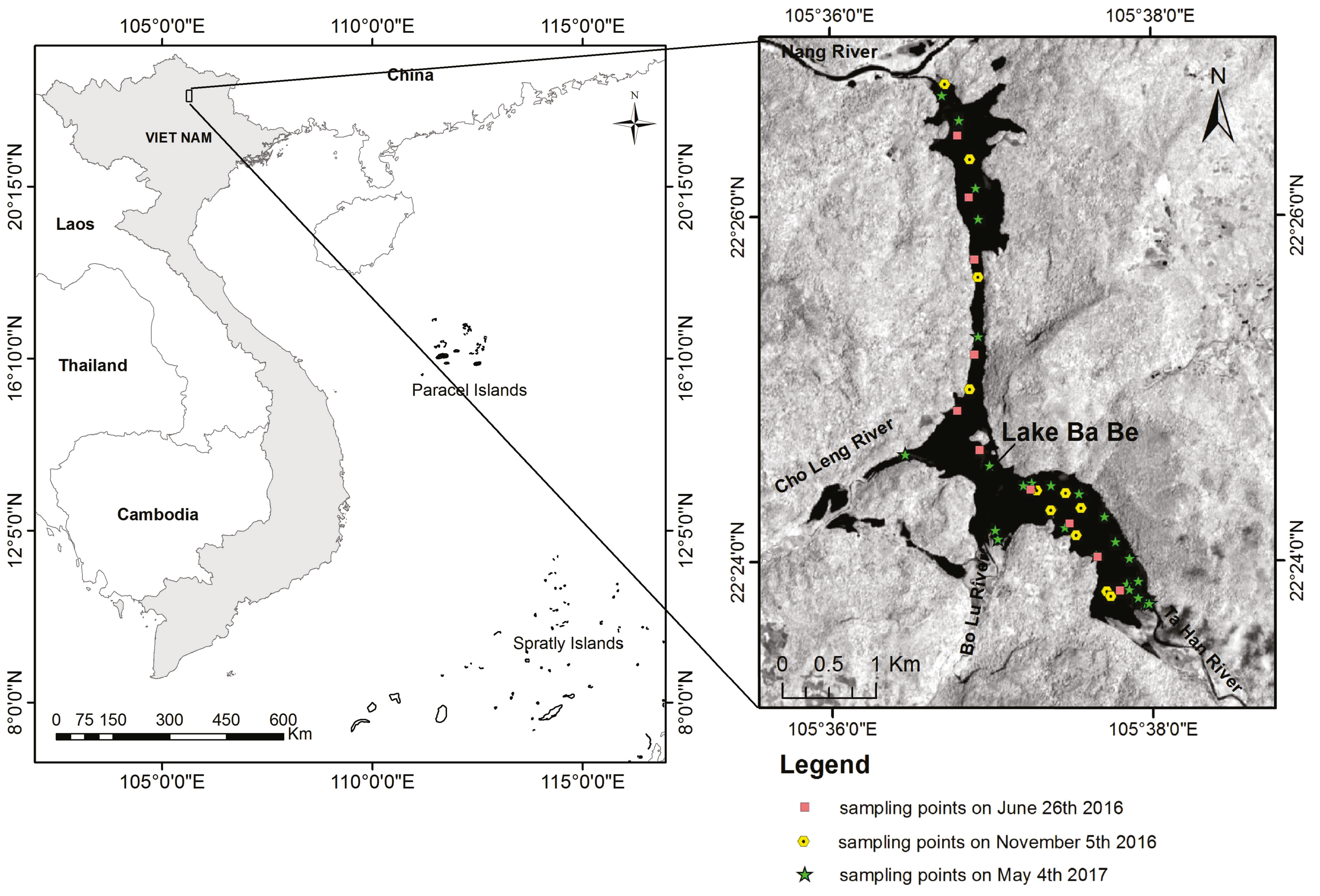
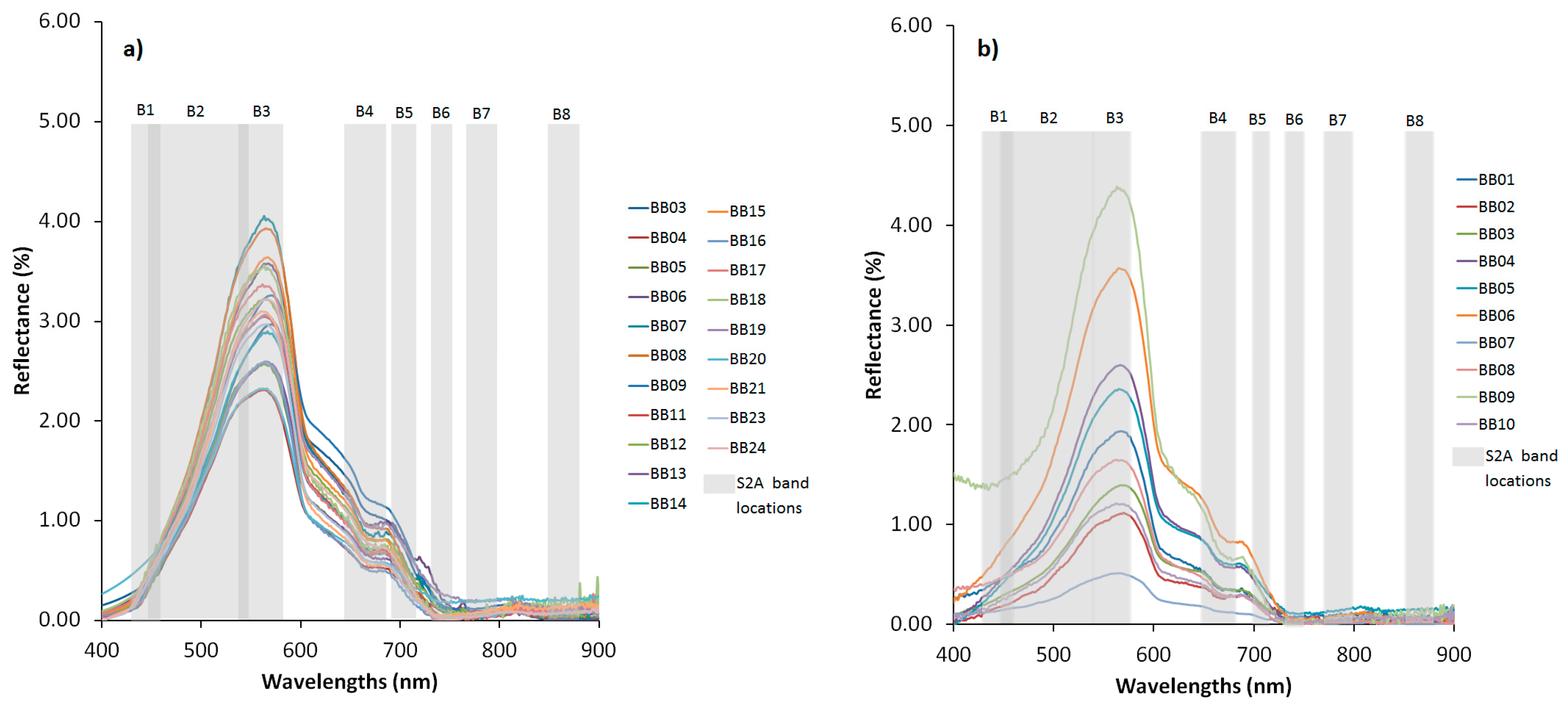
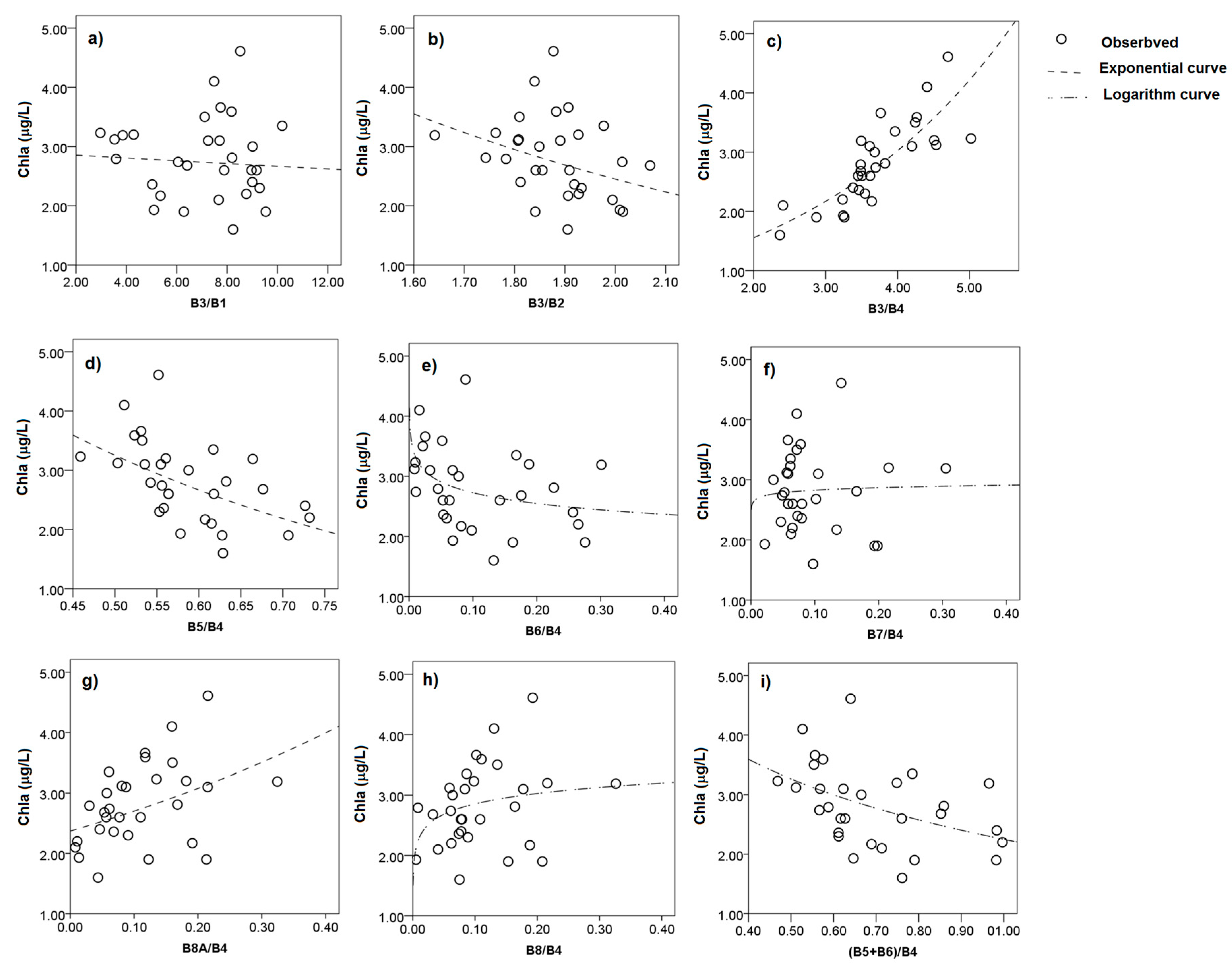
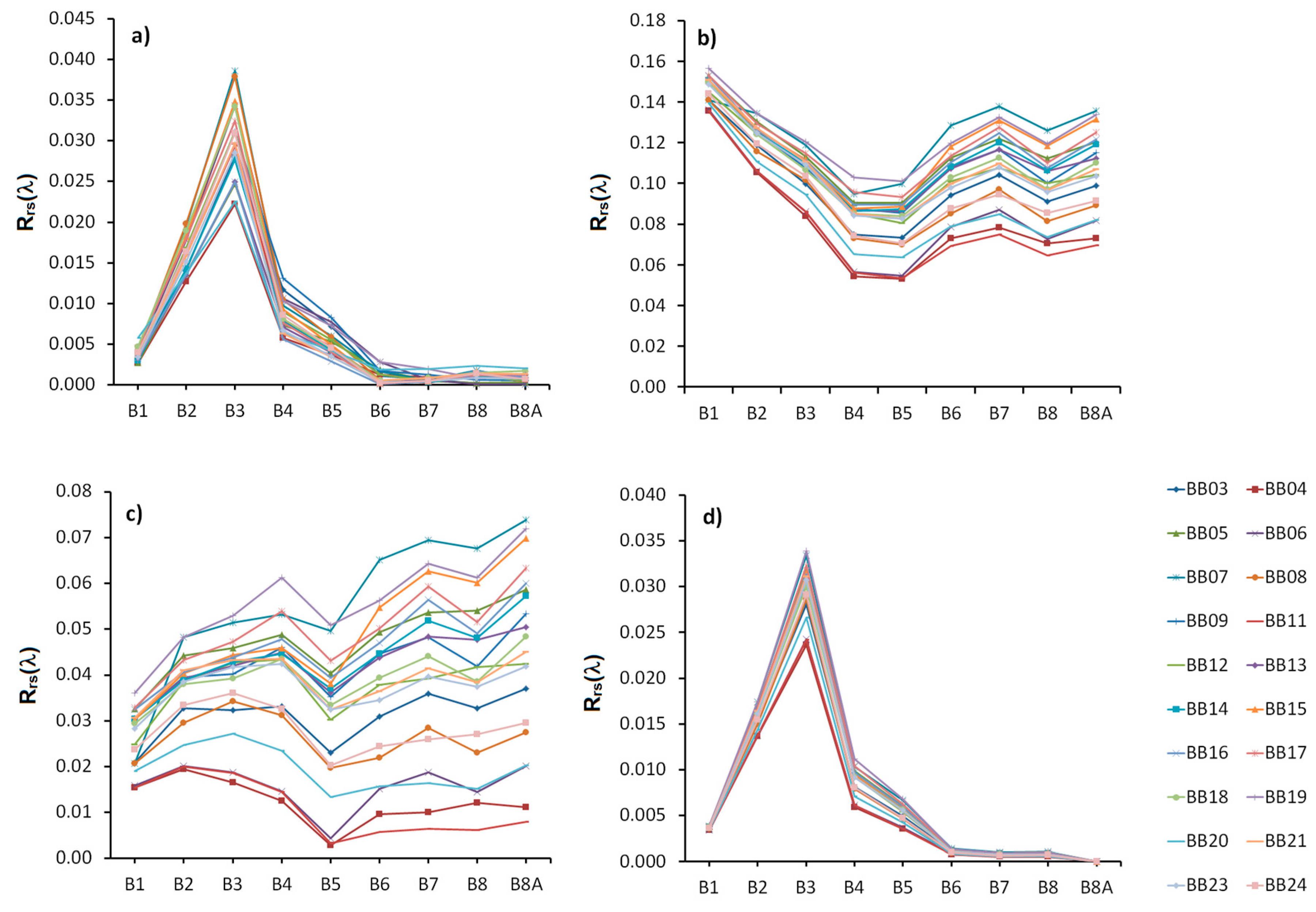
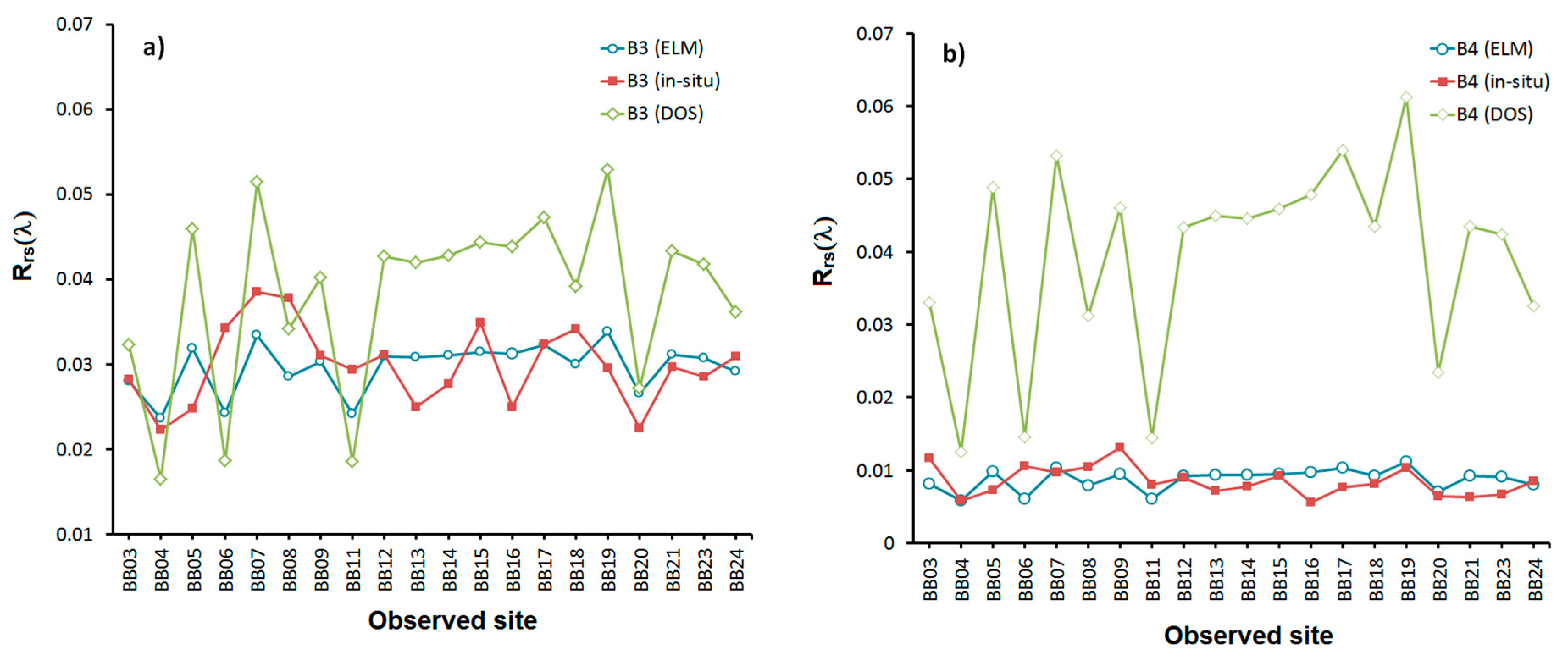
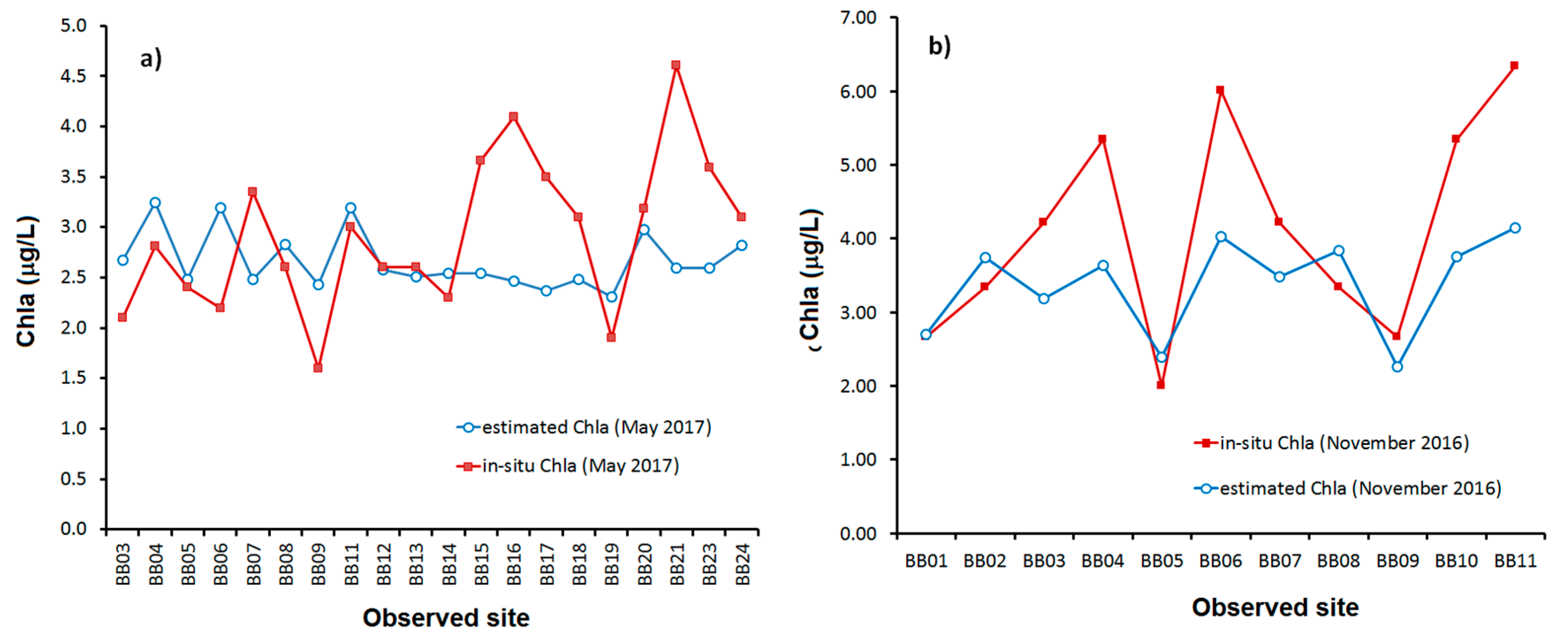
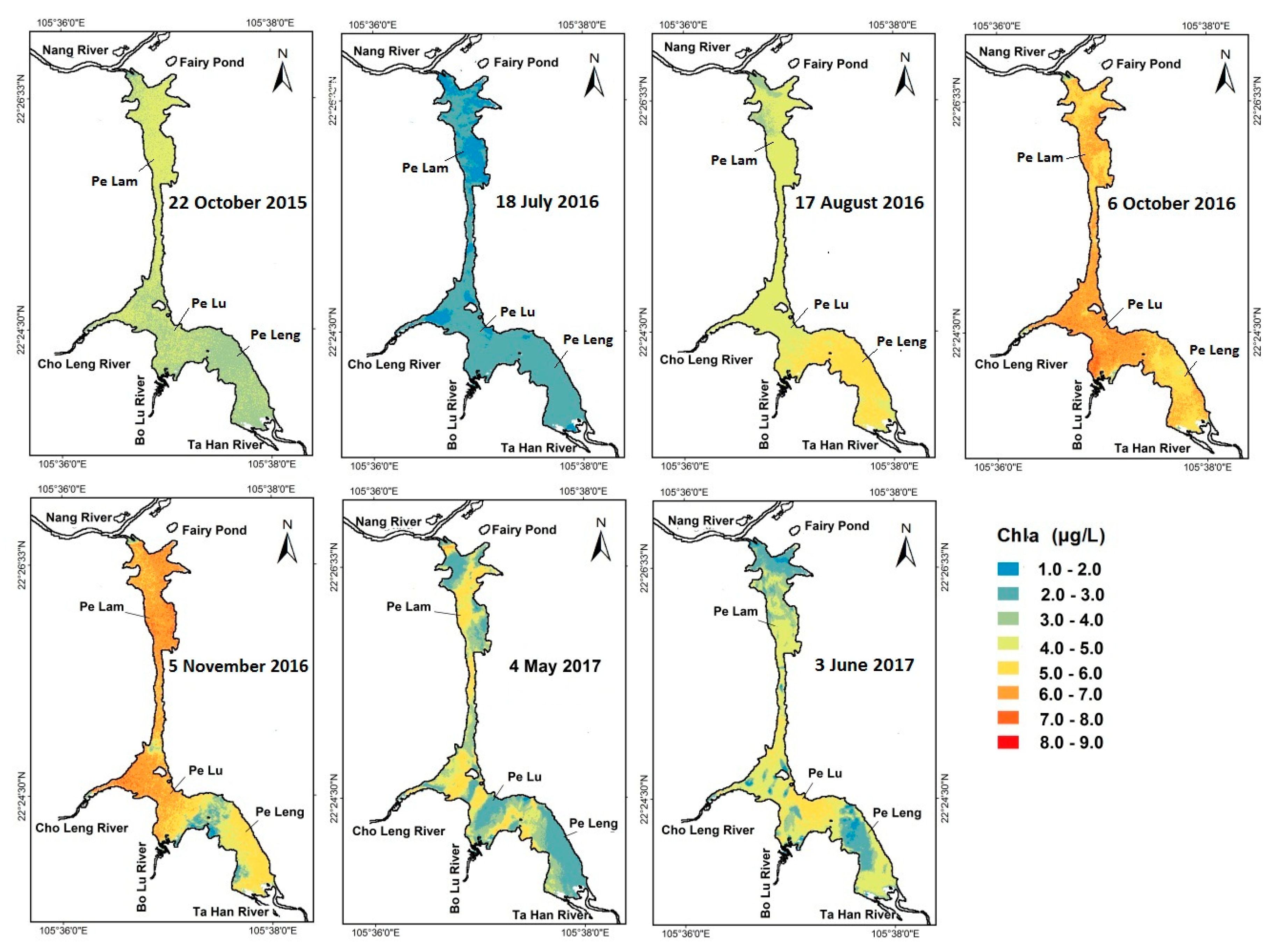
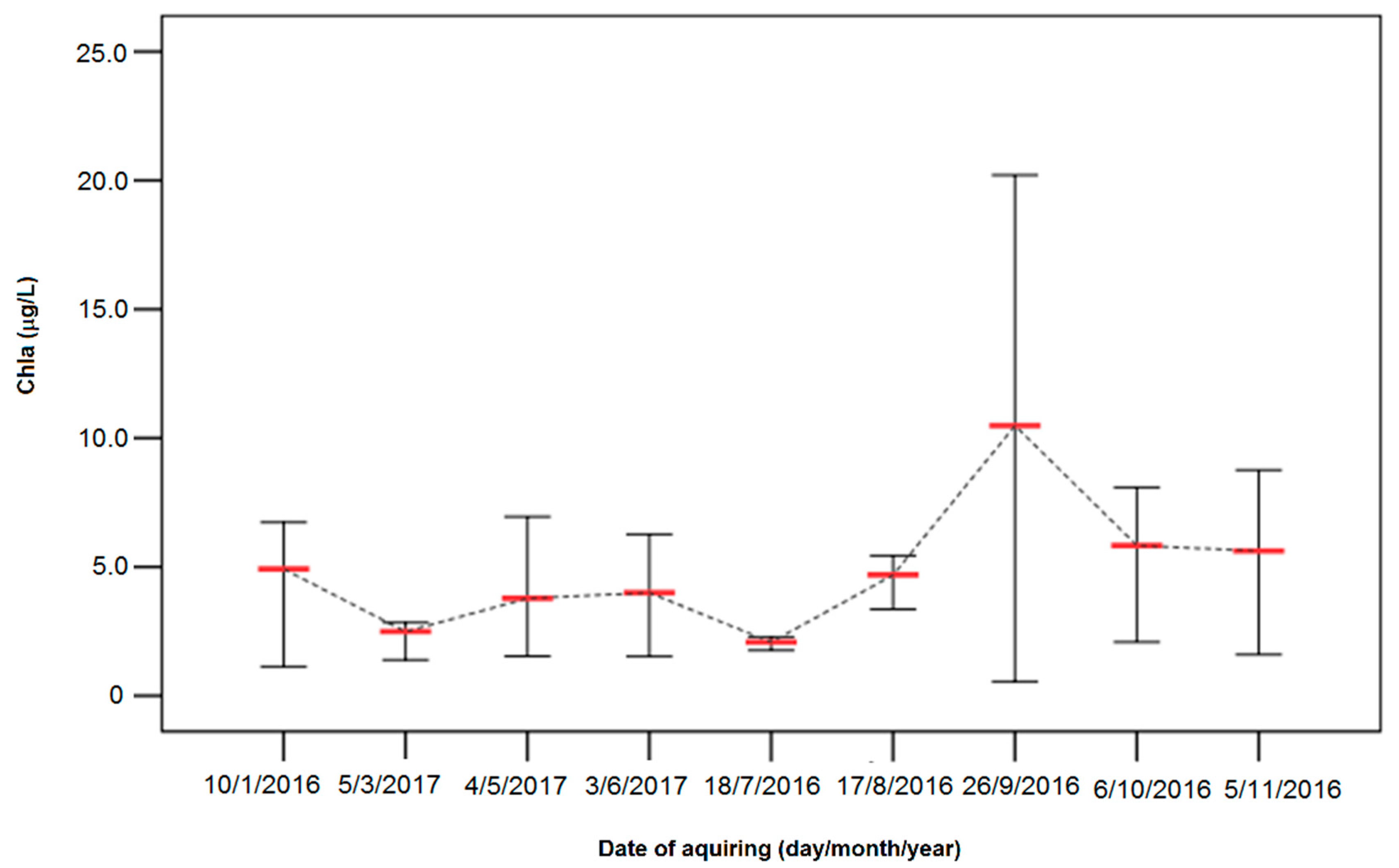
| Parameters and Measured Dates | N | Minimum | Maximum | Mean | Standard Deviations | |
|---|---|---|---|---|---|---|
| 4 May 2017 | Chla (μg/L) | 20 | 1.58 | 4.61 | 2.92 | 0.77 |
| SD (m) | 4.5 | 7.0 | 5.0 | 1.0 | ||
| 5 November 2016 | Chla (μg/L) | 11 | 2.00 | 6.00 | 3.77 | 1.45 |
| SD (m) | 2.0 | 7.0 | 5.0 | 1.5 | ||
| TSS (mg/L) | 18 | 22 | 20.5 | 0.85 | ||
| 26 June 2016 | Chla (μg/L) | 10 | 1.90 | 3.23 | 2.61 | 0.5 |
| SD (m) | 2.1 | 6.5 | 4.5 | 2.2 | ||
| TSS (mg/L) | 20.5 | 23.2 | 21.2 | 0.57 | ||
| Algorithms | S2A Band Ratio | Linear | Exponential | Logarithms | |||||||||
|---|---|---|---|---|---|---|---|---|---|---|---|---|---|
| R | r2 | SE | p | R | r2 | SE | p | R | r2 | SE | p | ||
| Green-blue two-band ratio | B3/B1 | 0.04 | 0.00 | 0.70 | 0.84 | 0.07 | 0.00 | 0.25 | 0.71 | 0.05 | 0.00 | 0.70 | 0.77 |
| B3/B2 | 0.32 | 0.11 | 0.66 | 0.08 | 0.35 | 0.12 | 0.24 | 0.06 | 0.32 | 0.10 | 0.66 | 0.09 | |
| Green-red two-band ratio | B3/B4 | 0.80 | 0.65 | 0.42 | 0.00 | 0.82 * | 0.68 * | 0.14 * | 0.00 * | 0.80 | 0.63 | 0.42 | 0.00 |
| NIR-red two-band ratio | B5/B4 | 0.54 | 0.29 | 0.59 | 0.00 | 0.54 | 0.29 | 0.21 | 0.00 | 0.54 | 0.29 | 0.59 | 0.00 |
| B6/B4 | 0.32 | 0.11 | 0.66 | 0.08 | 0.39 | 0.15 | 0.65 | 0.03 | 0.33 | 0.11 | 0.24 | 0.08 | |
| B7/B4 | 0.01 | 0.00 | 0.70 | 0.96 | 0.01 | 0.00 | 0.25 | 0.94 | 0.05 | 0.00 | 0.70 | 0.79 | |
| B8A/B4 | 0.42 | 0.18 | 0.64 | 0.02 | 0.48 | 0.23 | 0.61 | 0.00 | 0.40 | 0.16 | 0.23 | 0.30 | |
| B8/B4 | 0.28 | 0.08 | 0.67 | 0.14 | 0.25 | 0.06 | 0.24 | 0.18 | 0.31 | 0.01 | 0.67 | 0.09 | |
| NIR-red three-band ratio | (B5 + B6)/B4 | 0.43 | 0.18 | 0.63 | 0.02 | 0.43 | 0.18 | 0.23 | 0.02 | 0.44 | 0.20 | 0.63 | 0.01 |
© 2017 by the authors. Licensee MDPI, Basel, Switzerland. This article is an open access article distributed under the terms and conditions of the Creative Commons Attribution (CC BY) license (http://creativecommons.org/licenses/by/4.0/).
Share and Cite
Ha, N.T.T.; Thao, N.T.P.; Koike, K.; Nhuan, M.T. Selecting the Best Band Ratio to Estimate Chlorophyll-a Concentration in a Tropical Freshwater Lake Using Sentinel 2A Images from a Case Study of Lake Ba Be (Northern Vietnam). ISPRS Int. J. Geo-Inf. 2017, 6, 290. https://doi.org/10.3390/ijgi6090290
Ha NTT, Thao NTP, Koike K, Nhuan MT. Selecting the Best Band Ratio to Estimate Chlorophyll-a Concentration in a Tropical Freshwater Lake Using Sentinel 2A Images from a Case Study of Lake Ba Be (Northern Vietnam). ISPRS International Journal of Geo-Information. 2017; 6(9):290. https://doi.org/10.3390/ijgi6090290
Chicago/Turabian StyleHa, Nguyen Thi Thu, Nguyen Thien Phuong Thao, Katsuaki Koike, and Mai Trong Nhuan. 2017. "Selecting the Best Band Ratio to Estimate Chlorophyll-a Concentration in a Tropical Freshwater Lake Using Sentinel 2A Images from a Case Study of Lake Ba Be (Northern Vietnam)" ISPRS International Journal of Geo-Information 6, no. 9: 290. https://doi.org/10.3390/ijgi6090290
APA StyleHa, N. T. T., Thao, N. T. P., Koike, K., & Nhuan, M. T. (2017). Selecting the Best Band Ratio to Estimate Chlorophyll-a Concentration in a Tropical Freshwater Lake Using Sentinel 2A Images from a Case Study of Lake Ba Be (Northern Vietnam). ISPRS International Journal of Geo-Information, 6(9), 290. https://doi.org/10.3390/ijgi6090290





